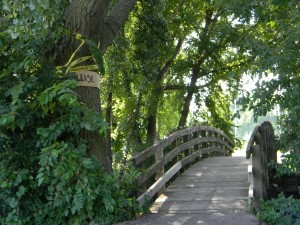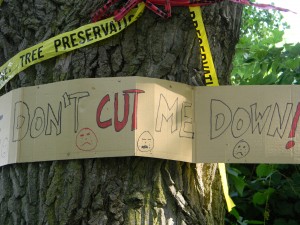UPDATE:

Construction on a new bike path through Warner Park will destroy this beautiful old tree, to make room for a new, wider, steel bridge. This bridge is used daily for photographs, weddings, fishing, and just peaceful, shaded musing.
Wild Warner proposed an alternate route, but lost the battle. Our proposal is below. If you disagree with the decision, and would still like to save this tree, contact city Parks or your alder.

Here is our original position paper:
Wild Warner has asked the city of Madison to revise its proposed new bike path through Warner Park in a way that would 1) save money, 2) preserve the beloved wood bridges and the trees around them, and create a pedestrian-friendly waterfront strolling lane, 3) meet ADA standards and 4) improve bicycle access to the Warner Park Community Center.
The following letter was sent to city officials
On Dec. 4, 2012, a representative from the city engineering dept. addressed our group concerning plans for reconstructing the Warner Park bike path. We believe some some changes in the area of the main park shelter will improve the plan for bicyclists, pedestrians, and groups using the shelter.
As the path is now, there are two small wooden arched bridges, one to the north and one to the south of the shelter. Your plan calls for replacing the north bridge with a new wider steel bridge and on the south side, building a new steel bridge several yards east of the existing bridge. This would improve traffic flow around the shelter.
We think a couple changes to the plan would make it even better. First, we like the idea of straightening the path and adding a new bridge south of the shelter. What we would like to see changed is for the path to continue more or less in a northerly direction, almost to the Community Center, where it can join an existing path, bend to the west, and rejoin the existing path. There are several advantages to this. First, bike traffic is directed further away from the shelter, so there will be fewer conflicts with groups and parties using the shelter area. Second, it creates a more direct route to the community Center. Third, it eliminates the need for a new bridge on the north side because the new route goes to the east of the water.
So, what we would have is a straighter path that is further away from the shelter. This would also have the effect of making the whole shelter area more relaxed and pedestrian friendly, because the bike traffic is removed. The two wooden bridges and and the path between them could remain as they are now. It would also remove conflicts in the traditional wedding area. Also, the relocated path will create a direct connection between the shelter and the Warner Park Community Recreation Center. There is no direct connection now.
Another good reason for making these changes to the plan is that it saves the existing wooden bridges. The southerly bridge has nesting barn swallows and is known as “the swallow bridge.” The westerly bridge is known as “the wedding bridge.” This area, with the large cottonwood tree and several river birches, is the site for many wedding photos and is also the subject of a large artwork in community room 2 of the Warner Park Community Recreation Center.
By slightly changing the direction of the path as we suggest, the city will save the cost of a new steel bridge and the expense of tearing out the wooden bridges. That savings will pay for maintenance of the bridges for many, many years.
We do not believe that the “Americans With Disabilities Act” is a valid reason for tearing out the wooden bridges. Whether they are in violation now can be argued. Besides, the new path will provide excellent access to the shelter area.
Tim Nelson, chair

You must be logged in to post a comment.